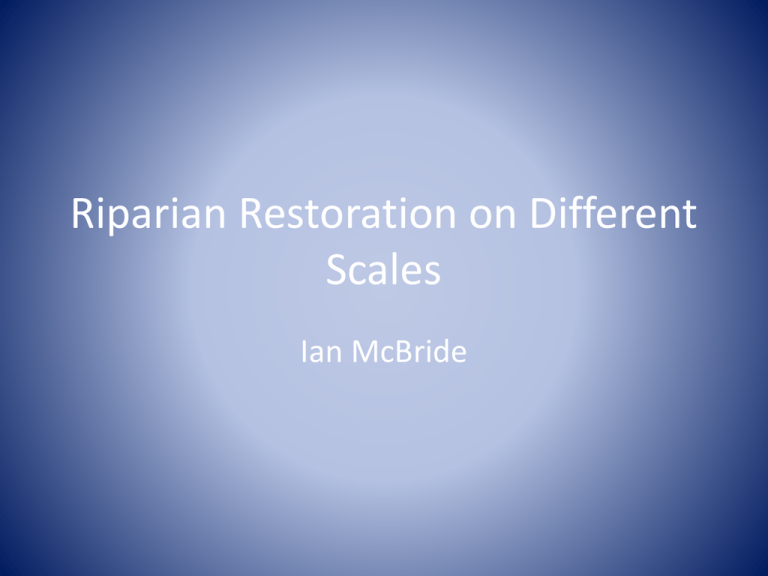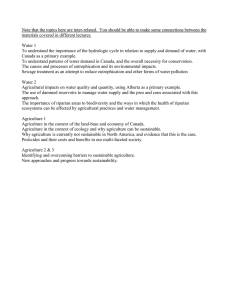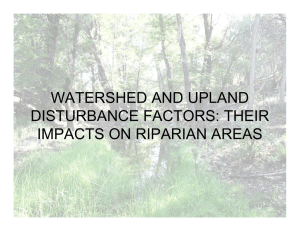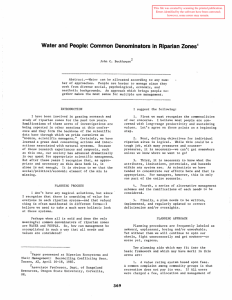Riparian Restoration on Different Scales Ian McBride
advertisement

Riparian Restoration on Different Scales Ian McBride Overview • Part 1: Project Monitoring Report OWEB Grant 204372C – Coos Watershed Association Projects 2004 Riparian Coos Watershed Association October 23, 2008 • Part 2: Sandy River Riparian Habitat Protection Project Report 2006, The Nature Conservancy, Oregon Field Office • Part 3: Statewide Survey of Oregon Watershed Enhancement Board Riparian and Stream Enhancement Projects 2002, By: Matthew Anderson and Gino Graziano Part 1: OWEB Project Monitoring, Coos Watershed Association 2008 Introduction • Monitoring report from 2002-2008 • Coos Watershed • Riparian restoration through planting • Completed with grant money Scope • 40 acres • 6 years • 6 land owners • Over $47,000 Focus • Restoring riparian areas • Increase salmonid production • Limiting live stock degradation Method • Planting of riparian vegetation • Large variation of species • Land owner involvement Results • Very successful riparian vegetation restoration Results Successful Species Unsuccessful Species • Sitka Spruce • Red Elder Berry • Western Red Cedar • Dogwood • Vine Maple Results • Land owners have stayed committed • Grazing limited away from riparian zone Conclusion • Annual monitoring • Continued up-keep • Landowner involvement Part 2: Sandy River Riparian Habitat Protection Project Report 2006, The Nature Conservancy, Oregon Field Office Introduction • Riparian restoration of sandy river • 4 year span 2002-2006 • Major focus on removal of invasives Scope • 395 individual microsites • Infestations of non-native invasive plants • Tens of millions of dollars • 25 years time scale Scope Knotweed • Non-native shrub • Extremely invasive • Rhizomal • Out competes better species Methods of Removal Physical • Cutting • Rhizome extraction Chemical • Herbicidal spray • Herbicidal injection Results • Number of knotweed steams found per year Results • Number of micro sites with knotweed present Results 2004 2005 2006 Results 2004 2005 2006 Results 2005 2004 2006 Part 3: Statewide Survey of Oregon Watershed Enhancement Board Riparian and Stream Enhancement Projects 2002 By: Matthew Anderson and Gino Graziano Scope • Compilation of restoration projects • Entire state of Oregon • 15 years of OWEB data 1987-2002 Findings • Riparian plant mortality in different areas of the state varies greatly • Potential reported causes: – Animal Damage – Desiccation – Plant Competition – Soil Conditions Willamette, North Coast, South Coast, and Lower Columbia Basins • Coos watershed • Sandy watershed Umpqua, Rogue, and Klamath Basins Deschutes, John Day, and Umatilla Basins Grande Ronde and Powder Basins Conclusion Part 1 and Part 2 Part 3 • Similar climates • Illustrate differences • Similar challenges • Very different scales state wide • Magnitude of scope • Tailor projects accordingly Conclusion Components of success state wide: • Preparedness • Knowledge of region • Landowner coordination and cooperation • Continued up-keep and monitoring Thank You!





